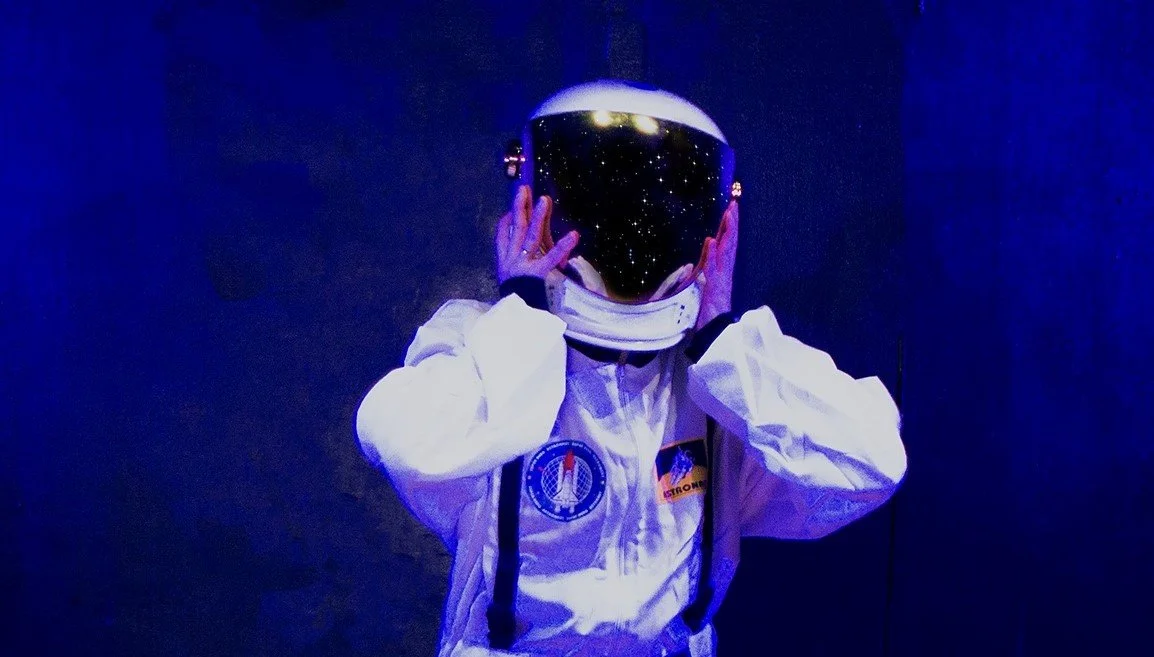Haley Rice is adrift in the cosmos in Isaac Byrne’s Letters to a Young Cosmonaut.
On the lam criminals, a would-be king living as an exiled stoner, an untethered cosmonaut, and a pair of lovers sorting through the detritus of a terminated relationship are the characters populating Isaac Byrne’s Under the Dragon’s Tail. Byrne also directs the quartet of one-acts that are not always in perfect harmony, but as a quadriptych, they intriguingly show the ways in which elements of mythology, metaphor, and symbolism can give order to the chaos of the contemporary world.
The first play, Ophiology, takes place near a highway somewhere in the desert Southwest and involves a trio of renegades. (The performers all present as women in this production but as the script and character names indicate, their genders are not important.) Ace (a cool and sinister Aubrey Clyburn) is the leader of the group, and minutes before, Ace had killed a police officer presumably without provocation. Reggie (performed with appropriate emotional volatility by Melissa Mattos) is Ace’s lover and an unwitting participant in the Bonnie and Clyde-like adventure. Rounding out the triangle is the mortally wounded Jacky (Danielle Grisko, who effectively finds the dark humor in the character). A victim of the shoot-out, Jacky has to keep reminding the other two, “I’m not dead yet!”
Kat Donachie is Wednesday and Evan Simone Frazier is Ash in One. Two. Three., a play about the end of a relationship.
The play’s title refers to the infestation of rattlesnakes that the getaway car has inadvertently provoked. As it turns out, the wily snakes and devious people are not so different. Ophiology is reminiscent of Sam Shepard in the ways in which it focuses on American outlaws and applies black comedy, surrealism, and naturalist symbolism. For instance, when Ace instructs Reggie on snake instinct, the information can be taken as both a confession and omen for their relationship: “Rattlesnakes are mean but only because they don’t know any better. The rattle’s just a warning that they’re scared. Just the way nature programmed them.”
The design contributes to the sense of lost souls in an uncaring universe. Notably, Joshua Rose’s lighting and scenery capture the sense of rootless individuals under a vast canopy of stars, and Chris Cornwell has created a jarring and realistic soundscape. Unfortunately, the tone of the play is inconsistent, and it is neither funny enough nor bleak enough to hypnotically draw audiences into this topsy-turvy world.
In the retelling of the Greek tale, The Golden Fleece, Jason (performed with unbridled energy by Conor M. Hamill ), lays claim to his inheritance and throne by stealing the Golden Fleece. His former Argonaut glory is all but forgotten after all these millennia. Even though he may have been a player in his past life, he identifies as a victim. That is, it wasn’t his fault that his lover, Medea, couldn’t handle his intended marriage to Glauce: “I told [Medea] everyone’s doing it. Polyamory man. That’s the future. Open relationships. No walls. No strings. Just love, you know.” Jason’s tragic flaw, this play suggests, is his insurmountable sense of entitlement.
Letters to a Young Cosmonaut is a surrealistic nightmare in which a young woman (in an unnerving performance by Haley Rice) is metaphorically catapulted alone and unsupported into the cosmos. With only periodic help from the command center (Ksjusha Povod provides the recorded voice), the character’s plight shows what it is like to be utterly alone, frightened, and without a lifeline for support.
As Jason, Conor M. Hamill hopes to set the mythological record straight in The Golden Fleece. Photographs by Felipe Beltran.
The last play, a two-hander called One. Two. Three. is the most effective of the evening. The set-up is simple: Ash (a very moving Evan Simone Frazier) and Wednesday (nicely modulated Kat Donachie) have ended their relationship, and they are sorting through the seemingly endless emotional baggage and collected items of their time together. The details of the affair and the break-up are manifested through lyric poetry, religious allusions (including the characters’ names), and philosophical objects, such as references to Wittgenstein’s beetle box, Theseus’s ship, Sisyphus’s rock, and other thought experiments reflecting the ineffability of relationships and the impossibility of truly knowing another person. As the two lovers air old recriminations and spout platitudes about the course of true love, they pull one object after another out of their packed duffel bags. The action perfectly encapsulates the truism that relationships don’t develop; they accumulate.
While some of the images and allusions in Under the Dragon’s Tail call attention to the writer’s hand (and mind) at work, the best moments are those in which characters, and not belabored ideas, emerge from the play’s collective unconscious.
Under the Dragon’s Tail, presented by Theatre 4the People, plays through Aug. 14 at the Matthew Corozine Studio Theatre (357 W. 36th St., 2nd floor). For tickets, COVID guidelines, and performance schedule, visit theatre4thepeople.org.





